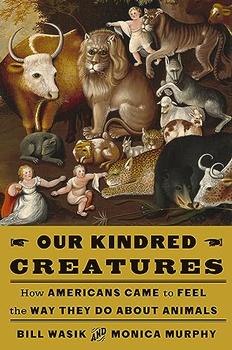
How Americans Came to Feel the Way They Do About Animals
by Bill Wasik
A compassionate, sweeping history of the transformation in American attitudes toward animals by the best-selling authors of Rabid
Over just a few decades at the end of the nineteenth century, the United States underwent a moral revolution on behalf of animals. Before the Civil War, animals' suffering had rarely been discussed; horses pulling carriages and carts were routinely beaten in public view, and dogs were pitted against each other for entertainment and gambling. But in 1866, a group of activists began a dramatic campaign to change the nation's laws and norms, and by the century's end, most Americans had adopted a very different way of thinking and feeling about the animals in their midst.
In Our Kindred Creatures, Bill Wasik, editorial director of The New York Times Magazine, and veterinarian Monica Murphy offer a fascinating history of this crusade and the battles it sparked in American life. On the side of reform were such leaders as George Angell, the inspirational head of Massachusetts's animal-welfare society and the American publisher of the novel Black Beauty; Henry Bergh, founder of the American Society for the Prevention of Cruelty to Animals; Caroline White of Philadelphia, who fought against medical experiments that used live animals; and many more, including some of the nation's earliest veterinarians and conservationists. Caught in the movement's crosshairs were transformational figures in their own right: animal impresarios such as P. T. Barnum, industrial meat barons such as Philip D. Armour, and the nation's rising medical establishment, all of whom put forward their own, very different sets of modern norms about how animals should be treated.
In recounting this remarkable period of moral transition—which, by the turn of the twentieth century, would give birth to the attitudes we hold toward animals today—Wasik and Murphy challenge us to consider the obligations we still have to all our kindred creatures.
"A colorful menagerie of characters fills this radiant history of the tumultuous first three decades (1866–1896) of America's animal welfare movement… a scintillating overview of how animals earned legal rights and moral sympathy in the latter half of the 19th century." —Publishers Weekly (starred review)
"Extensively researched... Of obvious appeal to animal lovers, this engaging account will also resonate with readers who enjoy in-depth looks at the history and shaping of contemporary American values." —Booklist (starred review)
"The authors of Rabid return with an examination of the historical shift in attitudes of Americans toward animals...A well-researched account that strikes a nice balance between description and analysis." —Kirkus Reviews
"[Our Kindred Creatures] is at once a model of historical recovery and a bracing takedown of our own attitudes toward those we caress and those we devour." —The American Scholar
"Our Kindred Creatures chronicles one of the great shifts in perspective of the 19th century: the recognition that the suffering and well-being of animals belong to the sphere of human morality. Populated by a cast of mesmerizing characters (and creatures), the book gives us a thrilling secret history of the 19th century, helping us understand how a new, world-changing idea first takes flight." —Steven Johnson, author of The Ghost Map
"I had no idea when I opened Our Kindred Creatures that I would be taken on a wild ride through the splendor, horror, and sheer strangeness of late-19th-century America. Nor did I realize that the authors would convince me that the fight against cruelty to animals played a key part in the American story, like abolitionism and the labor movement. This book is a wonder, as entertaining as it is instructive." —Charles C. Mann, author of 1491
This information about Our Kindred Creatures was first featured
in "The BookBrowse Review" - BookBrowse's membership magazine, and in our weekly "Publishing This Week" newsletter. Publication information is for the USA, and (unless stated otherwise) represents the first print edition. The reviews are necessarily limited to those that were available to us ahead of publication. If you are the publisher or author and feel that they do not properly reflect the range of media opinion now available, send us a message with the mainstream reviews that you would like to see added.
Any "Author Information" displayed below reflects the author's biography at the time this particular book was published.
Bill Wasik is the editorial director of The New York Times Magazine. Monica Murphy is a veterinarian and a writer. Their previous book, Rabid: A Cultural History of the World's Most Diabolical Virus, was a Los Angeles Times best seller and a finalist for the PEN/E. O. Wilson Literary Science Writing Award. They live in Brooklyn, New York.
Your guide toexceptional books
BookBrowse seeks out and recommends the best in contemporary fiction and nonfiction—books that not only engage and entertain but also deepen our understanding of ourselves and the world around us.